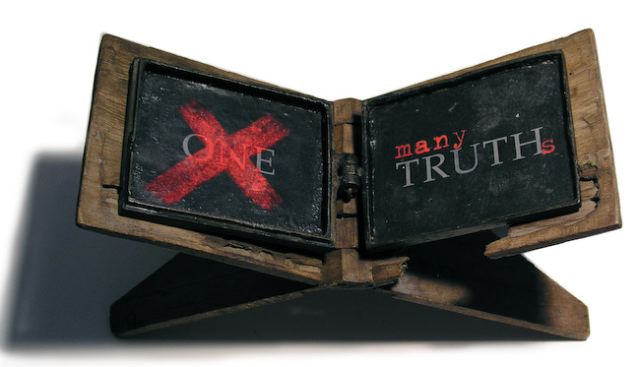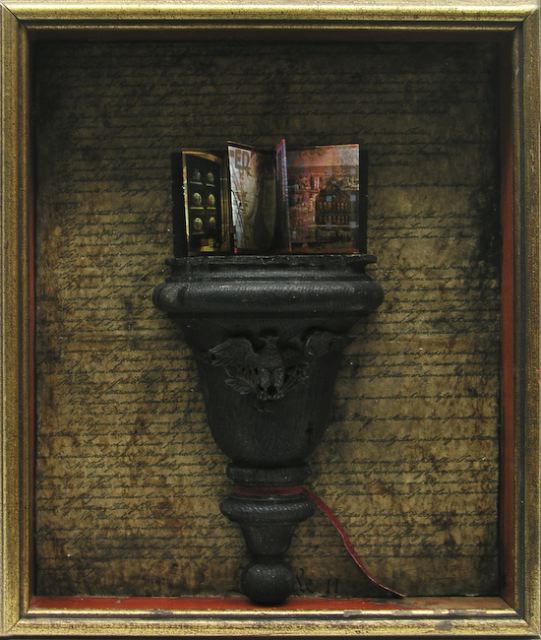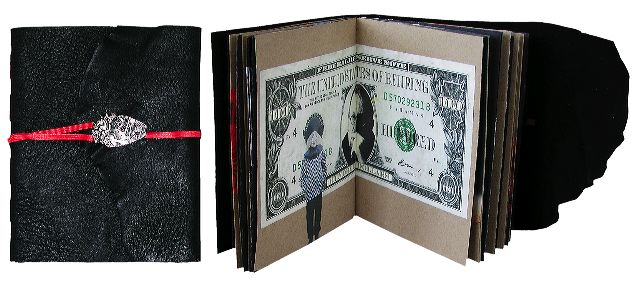India

7.25″ x 4.75″, 124 pages. Mixed media journal with paper hard cover. Made in India. A series of nine prints which combine scans of the journal pages with photographs, is called Jewel. The process of creating the prints and a page-turning book with images from the series can also be seen. Also related to this trip are two other series of work, Passages and Reflective Visions , and the books law and custom , many truths and Guardians.
Law and Custom

Mixed media triptych 8.75″ x ll” closed, 8.75″ x 22″ open. Components found in India. The text, which is below, refers to the status of women in India. THE DOWRY PROHIBITION ACT OF 1961 abolishes giving and taking dowry, (a valuable property or thing which is given by the brides family to the groom), at the time of marriage. In the First International Conference on Dowry and Bride-Burning in India held at Harvard University in 1995, Rani Jethmalani and Subhadra Chaturvedi, who practice law at the Supreme Court of India, stated that the government statistics are a result of gross under-reporting and the actual “unofficial” number of dowry death in India is between 12,000 and 13,000 every year. An equal number of brides are beaten so mercilessly that they become invalid for the rest of their lives. That makes an estimated total of 25,000 brides “killed or maimed” every year in India over dowry disputes. Himendra Thakur, Chairperson, Board of Directors, International Society Against Dowry and Bride-Burning in India, Inc. (ISADABBI) THE SUPPRESSION OF IMMORAL TRAFFIC IN WOMEN AND GIRLS ACT OF 1956-57 deals with prostitution and the welfare of fallen women. Every state is expected to appoint women police and social workers and set up protective homes where women will be given trainingso that they may earn a livelihood Probably more than a million women and children are employed in India’s brothels. Twenty percent of Bombay’s brothel population, estimated at 100,000, is thought to be girls under the age of eighteen, and half of that population may be infected with the human immunodeficiency virus (HIV). They are subjected to conditions tantamount to slavery and to serious physical abuse. Held in debt bondage for years at a time, they are raped and subjected to other forms of torture, to severe beatings, exposure to AIDS, and arbitrary imprisonment. Brothels are tightly controlled, and the girls are under constant surveillance. Escape is virtually impossible. Human Rights Watch Vol. 12, No. 5, October 2000 Chatterjee (1990) estimates every sixth infant death is due to gender discrimination. Of the 15 million girls born in India each year, nearly 25% will not live to see their 15th birthday. A daughter is viewed as a liability, and is conditioned to believe that she is inferior and subordinate to men. Sons are idolized and celebrated. “May you be the mother of a hundred sons” is a common Hindu wedding blessing. The origin of the Indian idea of appropriate female behavior can be traced to Manu in 200 B.C.: “In childhood a female must be subject to her father, in youth to her husband, when her lord is dead to her sons; a woman must never be independent.”
Many Truths

4.75″ x 10.5″ x 5.25″ tall, 2 pages Wooden book stand and metal book with paper and encaustic. Components found in India. Also related to this trip are three other series of work, Jewel, Passages and Reflective Visions, and the books Guardians, law and custom and India. Also related to this trip are three series of work, Jewel, Passages and Reflective Visions, and the books law and custom, Guardians and India.
Reserve

14″ x 11 ” x 1″ A minature book version of two murals produced for the Boston Federal Reserve Bank, sits atop a wooden pedestal with eagle in front of the section of the Articles of Confederation which authorize the federal banking system. Read about the making of the two murals, 15′ and 20′, and the five accompanying panels.
West

7.5″ x 6.75″ A collaged book exploring the settling of the west. The cover is patinaed copper and leather. The pages are Canson mi tiens and paste paper with collage, graphite, colored pencil and copper foil. Made in Santa Fe, NM.
Gulf Coast

14.5″ x 9.5″ x 3.5 closed, 14.5″ x 19″ x 2.5″ open Each year I make a piece for the Altars + Icons Benefit Auction at the New Art Center in Newton, MA. The hurricane Katrina’s devastation of the Gulf Coast, where I grew up, was in my thoughts as this portable “altar” was constructed.
Labeling Women

6″ x 5″ book, 40 pages Mixed media collage covered with marbled paper and silk spine. Created when I was a Visiting Artist at The American Academy in Rome, Labeling Women uses a variety of window and door frames cut from a piece of decorative paper to reveal glimpses of women selected from the art of Rome. They are “labeled”, correctly and incorrectly, with terms used to refer to women including sister, mother, mistress, dame, etc.See eight additional books created while in Rome.
Fasnacht

7.5″ x 6″ Mixed media colleged book with black leather cover, metal and red cord. Ephemera gathered at the 2005 Basel (Switzerland) Fasnacht celebration, a Protestant carnival. Viola Kaumlen shows photographs and gives a history of the Basler Fasnacht.
Milagros

3″ x 2″ x 1″ closed 3″ x 24″ open A concertina of old milagros attached to Arches black cover with glue, wire and string. The mirrored metal box was found in Santa Fe. Milagro is Spanish for miracle – the small metal objects are often nailed to crosses or placed in churches as requests or offerings.
Bingo

5.5″ x 4.5″ closed 5.5 ” x 27.5″ open A concertina of old bingo cards altered with silver leaf, metal, red and black paper and paint. The leatherette covered traveling box houses the concertina and the spinner.

